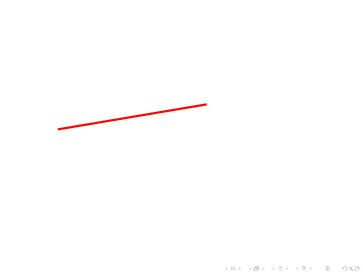Home
Brief CV
Research
Teaching
Outreach
Conferences
Software
Press
LHC and Philosophy

DFG RTG
|
[Up: aximate]
line
As opposed to a point, a line
needs two sets coordinates, determining where the line begins and where
it ends. Similar to point, these
coordinates can be given in polar form. For example,
foot => [[$xstart,$ystart],[$xend,$yend]]
fpolar => [[$rstart,$phistart],[$rend,$phiend]]
will put the start and the end coordinates of one end of the line to
($xstart,$ystart) + $rstart*(cos($phistart),sin($phistart))
($xend,$yend) + $rend*(cos($phiend),sin($phiend))
The options head and hpolar, defined in the same way
as foot and fpolar, will determine the position of the
other end of the line.
The aximation on the right corresponds to
line({"type" => "line",
"color" => "Red",
"foot" => [[20,20],[-50,-50]],
"fpolar" => [[10,30],[60,720]],
"head" => [[-120,0],[70,-50]],
"hpolar" => [[0,10],[0,80]]});
|

|
Options
"type" => "line", # what to draw [line,photon,gluon]
"foot" => [[-100,0],[0,100]], # center of foot coordinates
"head" => [[100,100],[200,100]], # center of head coordinates
"fpolar" => [[0,0]], # [r,phi] relative to foot
"hpolar" => [[0,0]], # [r,phi] relative to head
"dashlength" => [[0]],
"arrow" => 0,
"color" => "Black",
"width" => [[2]],
"amplitude" => [[10]], # amplitude of photon/gluon wiggles
"fixedwiggles" => 1, # fixed number of wiggles or fixed wiggle width?
"wiggles" => 3, # number of wiggles or wiggle width
"text" => "", # accompanying text
"textpos" => [[.5,10]], # position of accompanying text
main
|
